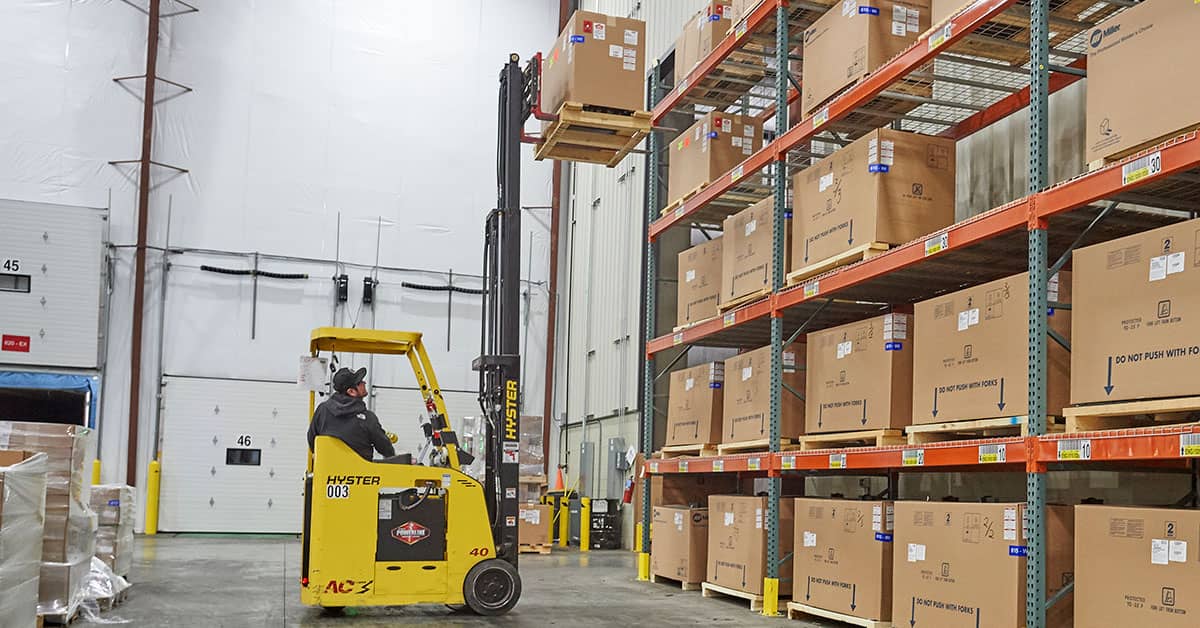Prevent under-ride hazards to stand-up forklift operators
Date Posted: 04/28/2025

One potential hazard to standup forklift operators is that when traveling in reverse near a storage rack or similar obstruction, a horizontal rack beam (crossbar) or similar obstruction might enter the operator’s compartment in a situation referred to as “under-ride.”
This “under-ride” hazard arises when the forklift operator backs up toward a storage rack. If the forklift body passes beneath the horizontal crossbar, the racking crossbar can enter the operator’s compartment and crush the operator.
The OSHA Cleveland Area Office investigated a fatality at a warehouse where a stand-up forklift operator was found pinned between the horizontal crossbar of a storage-rack shelving system and the operator’s compartment. The crossbar was 55 inches above the floor, while the top of the operator’s compartment was only 49 inches above the floor. Although the forklift had an overhead guard, the shelving rack was not positioned at the same level as the guard to prevent the under-ride. The forklift passed under the crossbar, which struck the operator above the waist and pinned his torso against part of the operator’s compartment. The operator died of asphyxiation injuries.
Recommendations
Employers should evaluate their worksite to determine if an under-ride hazard exists. If there are rack crossbars or similar obstructions in the facility, the employer should take one or more of the following actions:
- Modify the shelving systems by adjusting shelf heights so that either the body of the forklift operator’s compartment or the forklift overhead guard will strike the rack, preventing under-ride from occurring.
- Install a barrier along the outer edge of the storage rack (such as a curb or floor level shelf) so the bottom of the forklift will strike the curb or shelf, preventing an under-ride.
- Purchase stand-up forklifts that have corner posts, extended backrests, rear post guards, or other features to prevent an under-ride from occurring.
- Contact the manufacturer to discuss installing rear post guards or other protections that address the under-ride hazard on existing stand-up forklifts. Note that modifications and additions which affect safe operation must not be performed by the customer or user without the manufacturer’s prior written approval.
- Evaluate control methods to assure that guards do not limit visibility, create pinch-point hazards, or add any additional hazard to forklift operators or other employees.
- Train employees to operate forklifts safely, including recognizing the hazards of the workplace created by the use of the vehicles. (Training requirements can be found in 29 CFR 1910.178(l).)
How Safety Management Suite Can Help
Employers must train forklift operators on the type of equipment they’ll be using. Different styles of forklifts (such as stand-up units vs. sit-down units) pose different hazards. Refresher training must be provided if the operator was observed doing something unsafe or was involved in an accident or near-miss incident. The Training area of J. J. Keller® SAFETY MANAGEMENT SUITE can help, with online and classroom courses on many topics, including forklifts. You’ll also find handouts, quizzes, and other materials to supplement your training.
E-mail Newsletter
Sign up to receive the weekly EHS Insider email newsletter for safety articles, news headlines, regulatory alerts, industry events, webcasts, and more.